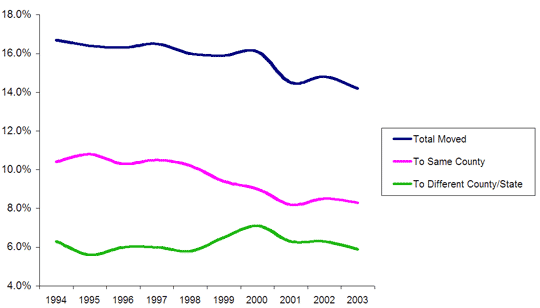
Vol. IV, No. 6, June 2004
- Editor's Corner
- Family Expenditures on Children
- More on Kids' Dining
- Foundations Just Around the Corner
- How's LOBEX Doing?
- Totter the Mascot
- Architects & Location-Based Entertainment Design
- Restaurant Start-Up & Growth Magazine
- American Girl Café
- Newly Published Work
- The Lavatory Factor
- Views of Paradise Park
- Are Your Guests All Moving Away?
- T-Rex Is Coming!
- New Projects
Are Your Guests All Moving Away?
There are only five ways for any location-based leisure facility to grow its business. In increasing degree of effort and cost, they are:
- Lower the guest defection rate (guests who don't return for various reasons)
- Increase the amount guests spend on each visit (higher per capita spending)
- Increase how often existing guests frequent the business (higher repeat business)
- Attract new guests from within the existing trade area
- Expand the geographic reach of the area (almost impossible)
The first three, which focus on existing guests and their experiences when they visit, are the easiest to accomplish and give the highest return on expended effort and investment. The last two are focused on attracting new guests and generate a much lower return on investment.
Unfortunately, most businesses mistakenly focus on the last two, assuming they are the best way to grow. In the process, they fail to concentrate on the first three, and most importantly, the first, guests who defect. Those businesses are constantly chasing after new guests, while existing guests are walking out the door and never returning. Our company has analyzed many existing LBEs for clients who wanted to improve sales and profitability. Consistently, we have found customer defection rates of anywhere from 25% to 50% and higher, meaning 25% to 50% of existing guests abandon the LBE each year. Just to stay even, these businesses must advertise to recruit large numbers of new guests to replace the ones they've chased away, the ones who never come back (and probably tell their friends not to, as well!). It's like pouring sand into a leaky bucket, as new guests simply replace old ones who've taken their time and money elsewhere. The truth is that focusing on the first three, and especially the first -- pleasing existing guests so they don't defect -- will usually take care of attracting new customers through positive word-of-mouth marketing. Focusing and investing on current guests rather than the ones you don't have realizes the greatest ROI.
Focusing on retaining existing guests accomplishes two things. First, you increase your sales by generating more revenue from existing customers over a longer period of time. Studies have shown that even a 5% decrease in defections can result in a 25% increase in profits. Secondly, you end up doing a better job of attracting new guests than the traditional route of advertising and discounting. You produce guests who are really happy with your business and want not just to return, but to tell their friends, as well. Powerful? You bet! Think about how you choose which restaurants to visit. Would you be more likely to visit one with a pretty ad in the newspaper or one that a friend praised to the skies? Yeah, we thought so.
There are many reasons guests defect. It can be because of a bad customer service encounter, dirty restrooms (see preceding article), broken equipment, poor quality food, excessive noise, unattractive ambiance, people moving out of the area, and hundreds of other possibilities. In fact, in today's world, with so many options competing for guests' limited time, it can be as simple as not offering a compelling enough experience to make guests want to return.
When we talk about defections, we sometimes hear the response that there is nothing a center can do about guests who move out of the community. That is true. So we decided to drill into some U.S. Census Bureau data to see what proportion of defections could be attributed to guests moving away.
Annual moving rates of Americans have decreased over the past decade, from 17% in 14% in 2003. This is the lowest moving rate since the Census Bureau began collecting moving data in 1948 when the moving rate was 20%.
Annual Moving Rates

 Moving
rates vary by demographic characteristics. Whites move less often (13%) than
Blacks (18%), Asians (17%) and Hispanics (18%). Families with children in
the younger years move more often than older childless adults and couples.
Married couples move less often (10%) than divorced, separated or never married
adults. Incomes affect moving rates, from a high of 19% for households with
the lowest incomes to 10% for households with the highest incomes. Homeowners
move only 25% as often as renters.
Moving
rates vary by demographic characteristics. Whites move less often (13%) than
Blacks (18%), Asians (17%) and Hispanics (18%). Families with children in
the younger years move more often than older childless adults and couples.
Married couples move less often (10%) than divorced, separated or never married
adults. Incomes affect moving rates, from a high of 19% for households with
the lowest incomes to 10% for households with the highest incomes. Homeowners
move only 25% as often as renters.
When people move, they don't necessarily move out of the community. In fact, the majority of moves (58%) are within the same county. For people who move out of the county, the distribution is the same for those who move to another county in the same state (19%) versus those who move to another state (19%). Four percent of moves are attributable to people who move abroad.
We analyzed the moving data and extrapolated what we believe the moving rate is for a family with children 12 years and younger that earns $50,000 or more per year in a typical suburban area. We assumed that 60% of those families that moved within the same county would still remain in the trade area for an LBE they frequented. The result was that 7.5% of families move each year outside of the trade area. So, 7.5% of the defection rate for a typical family-oriented LBE can be attributable to families moving out of the area.
If we go back and look at overall typical defection rates of 25% to 50%, that means the vast majority of guests who never return to an LBE do so for reasons other than moving away. It's rather frightening when you think about it. Even using the best case scenario of a 25% defection rate, the LBE is effectively chasing 17.5%, more than one-sixth, of its guests away each year. That's an awful big hole in the bottom of the bucket.
What does this mean? It means eventual disaster, as the time arrives when there are no longer enough new residents in the market area who can be attracted to replace all the ones that leaked out of the bottom of the bucket.
Vol. IV, No. 6, June 2004
- Editor's Corner
- Family Expenditures on Children
- More on Kids' Dining
- Foundations Just Around the Corner
- How's LOBEX Doing?
- Totter the Mascot
- Architects & Location-Based Entertainment Design
- Restaurant Start-Up & Growth Magazine
- American Girl Café
- Newly Published Work
- The Lavatory Factor
- Views of Paradise Park
- Are Your Guests All Moving Away?
- T-Rex Is Coming!
- New Projects


